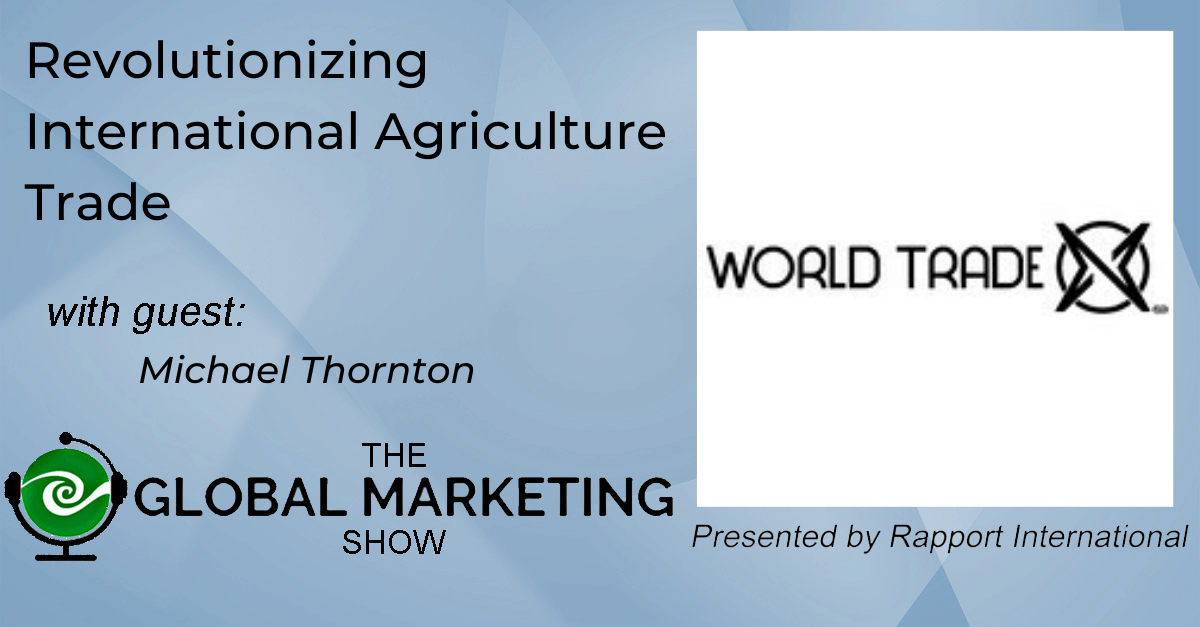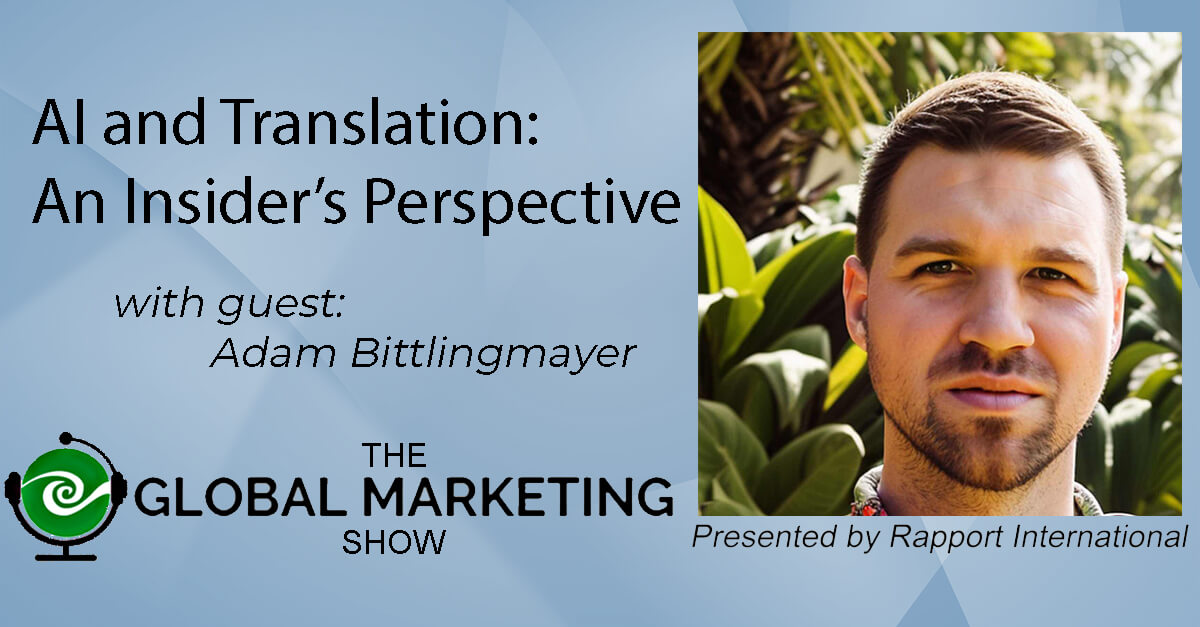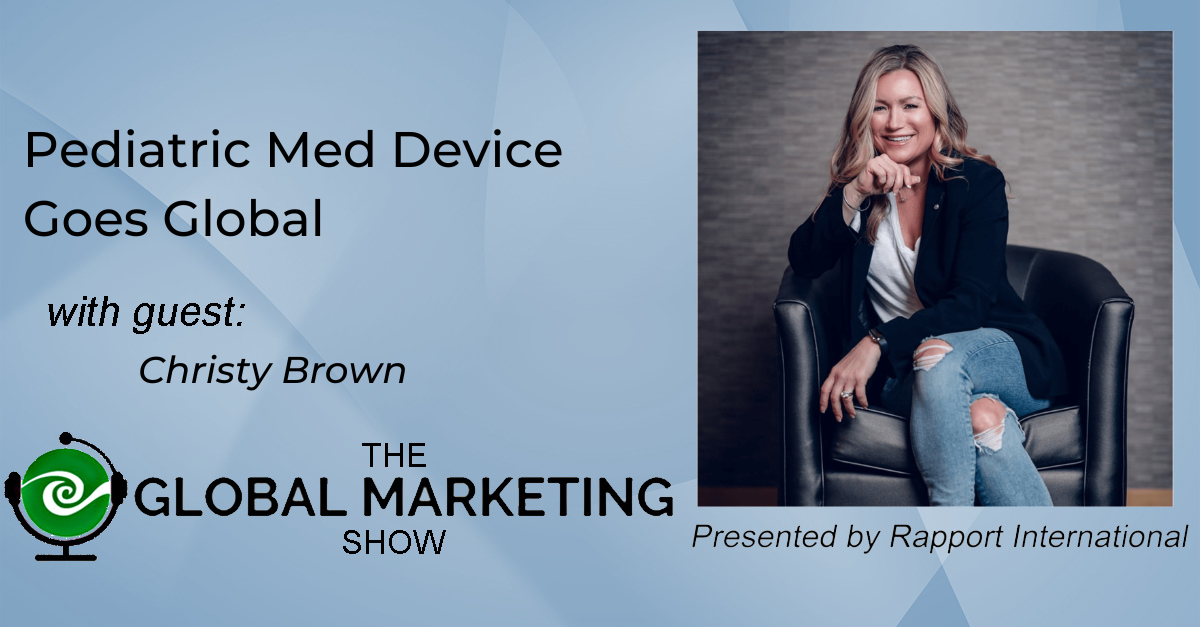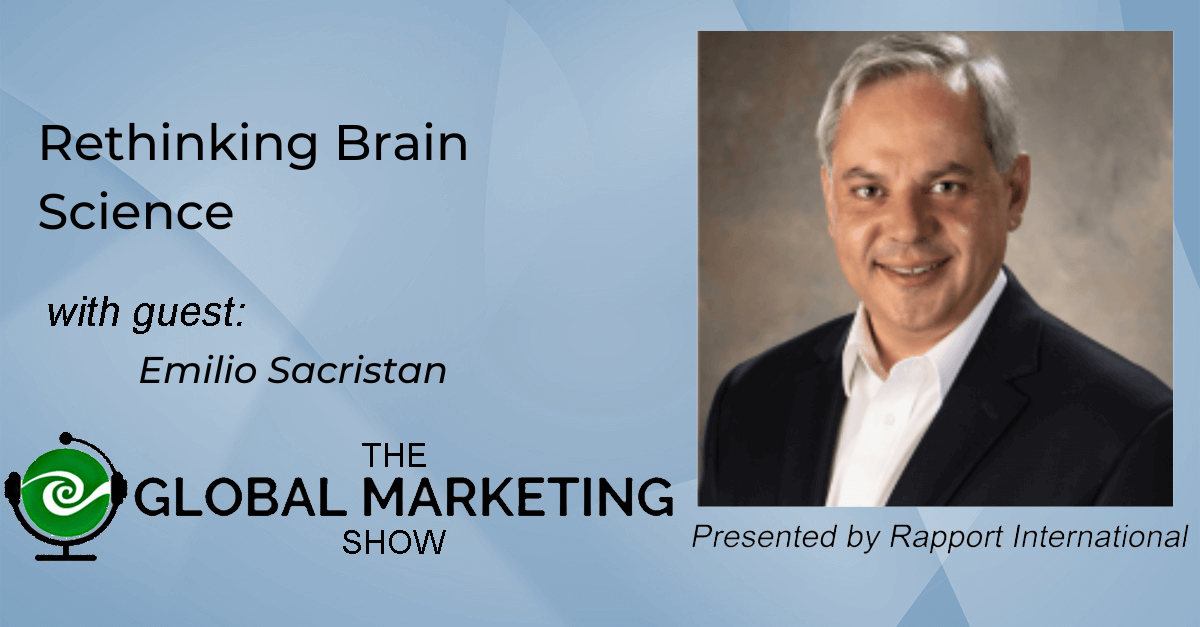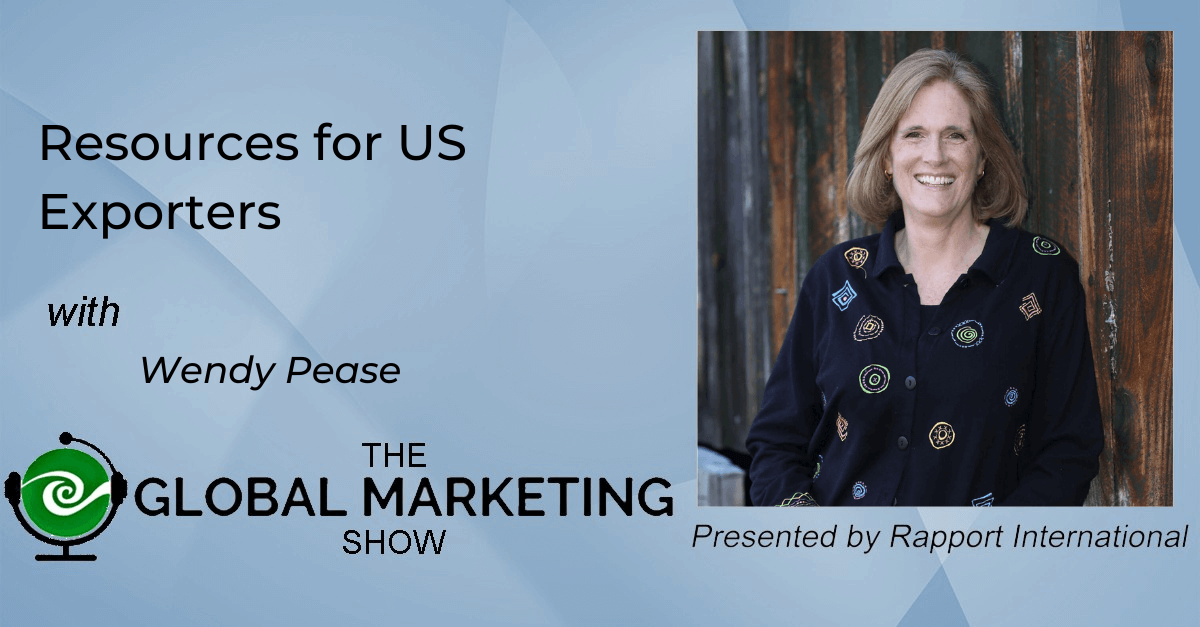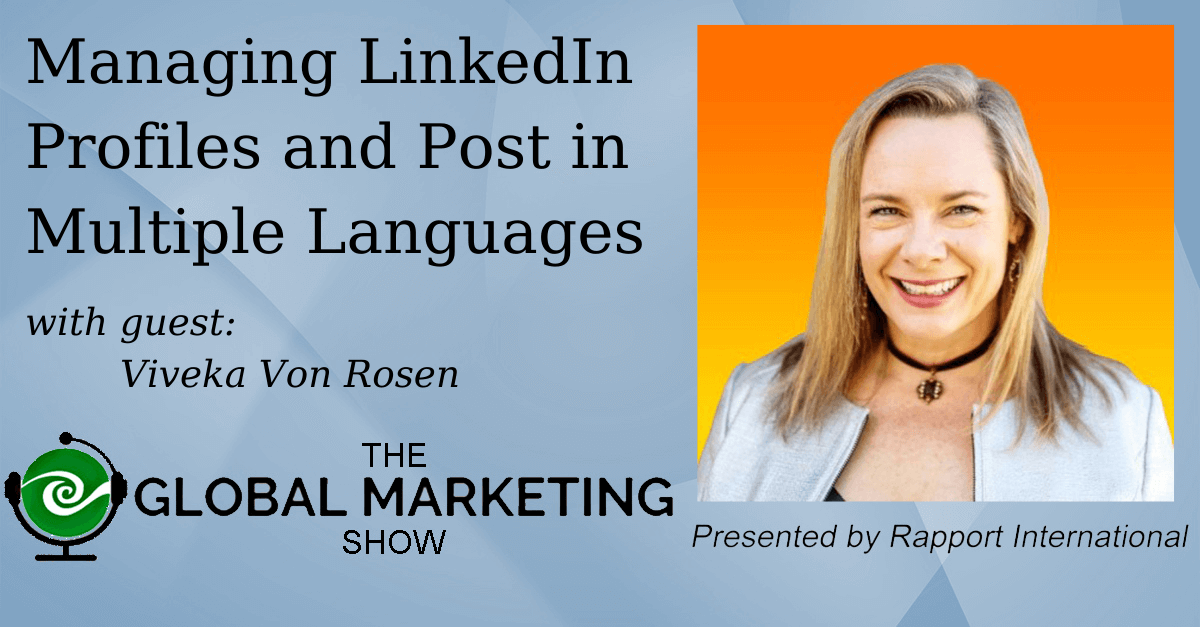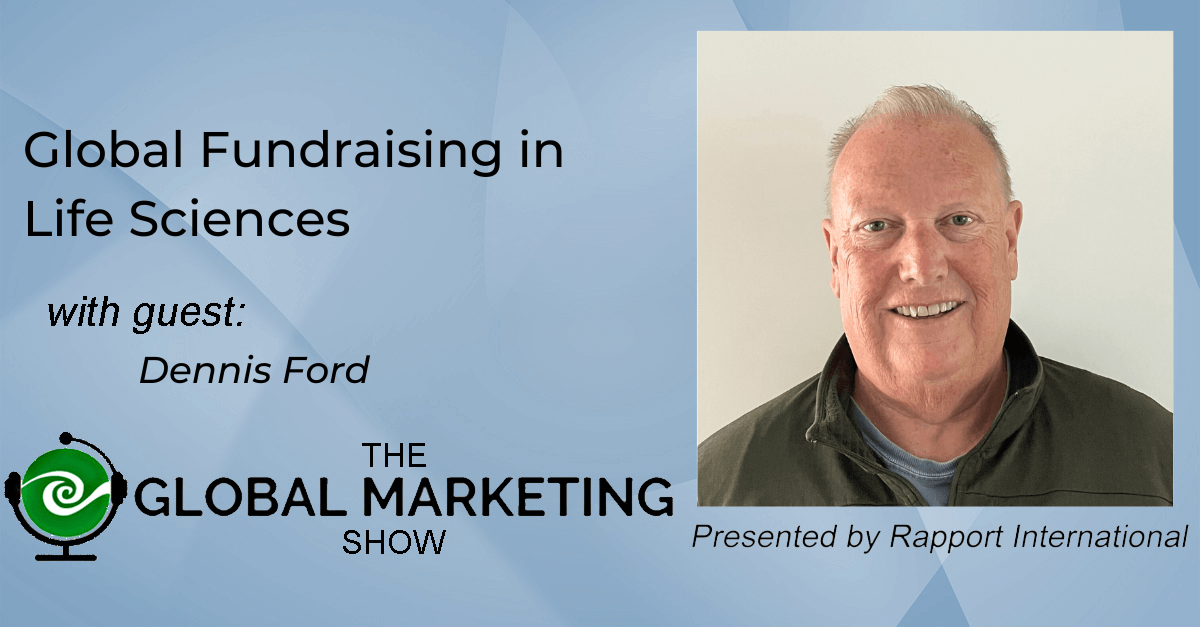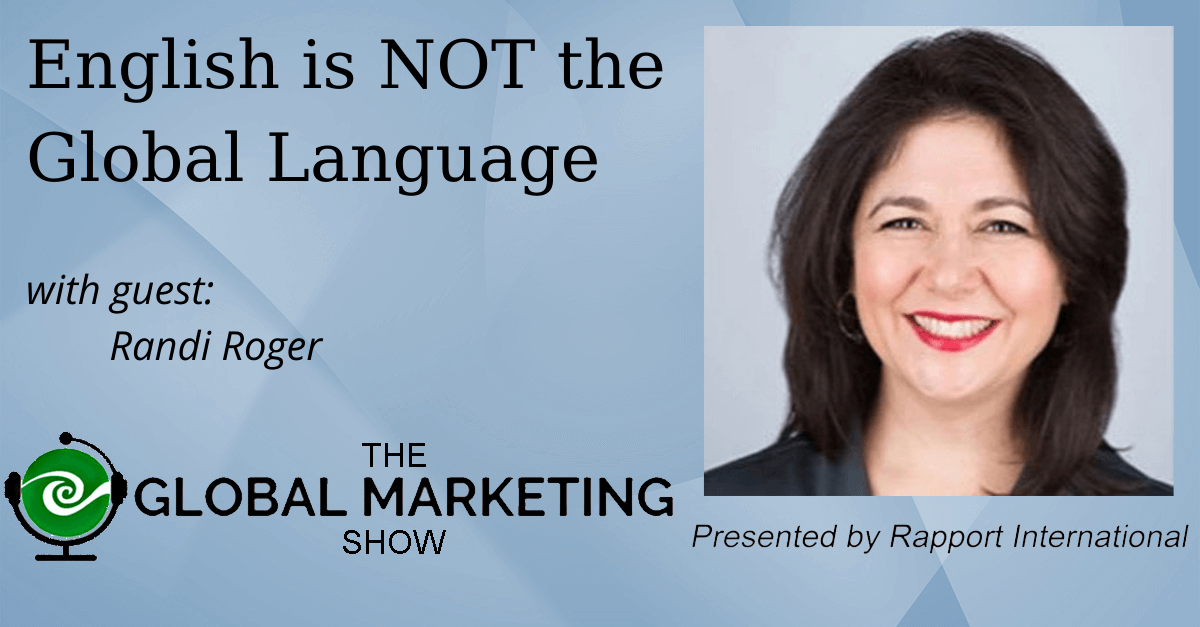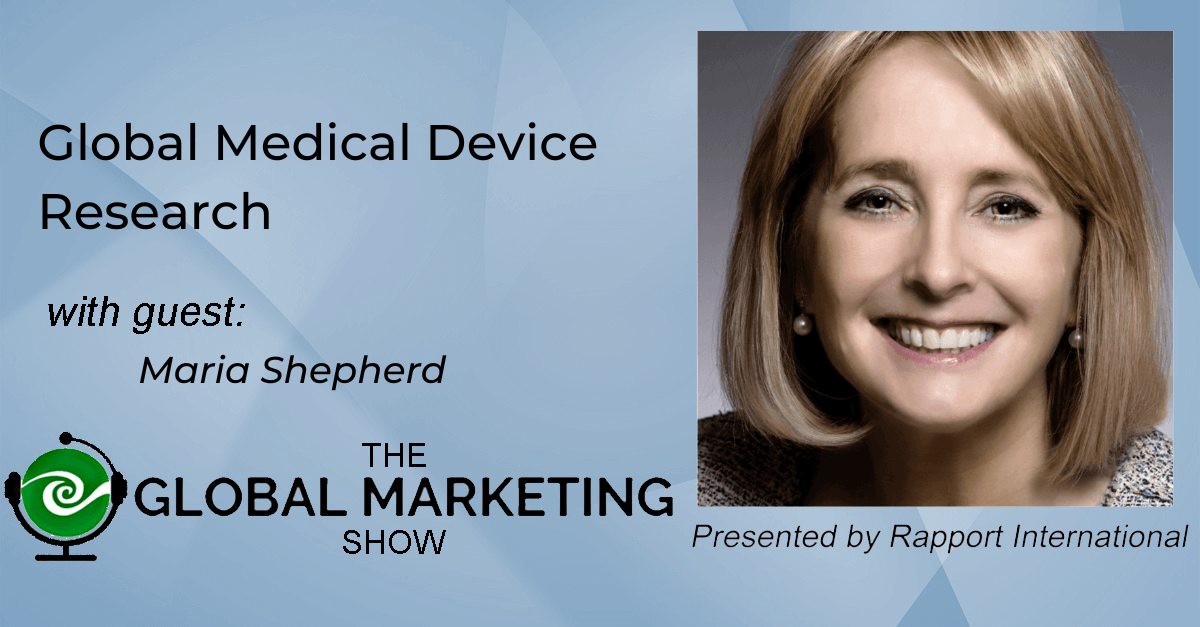Juha Vaisanen, Managing Partner of Active and Senior Living Markets Business Development and Sales with Technogym, explains why entering the US market is much different from entering other smaller countries.
If you don’t have the right segmentation and research, you compete and lose against bigger players.
He talks about his experience in finding a hot market for saunas and gym equipment.
And what your distributor can handle and why translation is better handled by the company.
A steamy episode for leaders who want to enter the US.
Links:
LinkedIn: https://www.linkedin.com/in/juhavaisanen/
Connect with Wendy: https://www.linkedin.com/in/wendypease/
Music: Fiddle-De-Dee by Shane Ivers - https://www.silvermansound.com
ATTENTION: Below is a machine generated transcription of the podcast. Yes, at Rapport International, we talk a lot about how machine translation is not good quality. Here you see an example of what a machine can do in your own your language. This transcription is provided as a gist and to give time indicators to find a topic of interest.
[00:00:34] Wendy: Hello listeners to the global marketing show. Thanks for joining us again. Uh, as you know, Rapport International sponsors this, and I've got a fun word for you that Lisa from Rapport International was talking about this weekend. She talked about a crazy trip that she did last minute that they planned she and her husband the night before, when they were having beers at a microbrewery.
[00:00:57] And she's like, Hey, that's like a schnapsidee. That's a German word. That means a crazy idea. That seemed like an ingenious plan that has hatched while drunk. It literally translate into a booze idea. So what's the latest schnapsidee that you've had. Well, onwards, onwards, onwards to our guest. He's not German, but he does not come from the United States.
[00:01:23] And he's doing really cool stuff here. Juha Vaisanen has years of experience with sporting goods and fitness equipment. And he currently represents HElo Sauna Company and Techno Gym, which are companies that provide solutions and equipment for active and senior living communities throughout the USA.
[00:01:47] HElo is based in Finland and Sweden and has a headquarters in the U S and Minnesota and Techno Gym is an Italian company with us headquarters in New Jersey. So welcome Juha I'm so excited to talk to you about this. Thank
[00:02:05] Juha: you for having me.
[00:02:06] Wendy: So first off, you've got to tell me what languages do you speak?
[00:02:11] Juha: I speak, I guess, English, Finnish, Swedish and a little bit German.
[00:02:18] Wendy: Okay. Have you ever heard the word schnapsidee before?
[00:02:21] Juha: I have heard her schnap several times, but not schnapsidee.
[00:02:27] Wendy: Is there any other word like that and Finnish or Swedish?
[00:02:31] Juha: Phineas it keep peace. And, uh, in the speed is it's, uh,
[00:02:38] Wendy: So if there it's what?
[00:02:47] Oh, okay. Okay. So how some, but not a snap city, like an idea that you had while you've been drinking that you think is brilliant.
[00:03:00] We don't have any word like that in the United States. So I was wondering if it, if it went across the finish or Swedish, but anyway, that's not why we're here. We're here to talk about your experience in international marketing. So it's very interesting to me that the companies you're working with now are focused on senior living communities.
[00:03:24] So can you tell us more about that?
[00:03:27] Juha: Both of these companies are large companies, so. Like Hilo sauna is the largest and oldest sauna company in the world. So they are servicing all the markets that, uh, what we do is I had been working with active and senior living communities for a long time, 15 years.
[00:03:50] So they I'm representing them in this segment while they, they have other, other people working with, uh, they have themselves for working directly with the other market. Segments. Technology is a, it's one of the largest fitness equipment companies in the world with close to a billion dollars in sales.
[00:04:14] And again, it's the same that because of my special B for active at senior living markets, which means that basically. 50 plus market then in senior active living communities are typically a 50 plus market. And then senior living residents are typically the age is somewhere around 82, average aged eight, seven blades, seventies, early eighties.
[00:04:39] That's the big goal. And obviously all the adults need different programs, different solutions, and entirely different setups than say 35 year olds. Uh, the source like safety they, they may have a functional limitations or they may be high risk.
[00:05:03] Wendy: And so how does, how do the companies adapt? What they have.
[00:05:09] For how you're trying to bring them into the market.
[00:05:12] Juha: Uh, I take example Technogym has a very broad product line. So they have products from, for everybody. They may have, uh, all, all types of products. So when we are, we are working with senior living communities or active living communities. We, we basically, when we do the designs, they need to be ADA compliant.
[00:05:37] So we do the design equipment recommendation, keeping in mind the safety, especially safety. So these messages need to be easy on, easy off. They need to be safe. They need to be non-intimidating. They need to have very low starting versus the. And increments, for example if you go to health club, I would say 70% of the messiness at the average held glove treadmills.
[00:06:06] I basically do not recommend treadmills to the senior living communities. It's just, the people may fall the same with the Hilo sauna. When you design southerners for let's agree, what they also held gloves or homes, it's entirely different process than many. You are designing them for the, for, uh, older adults.
[00:06:31] You need to add a flooring flooring that is non slippery. You need to avoid glass doors. People then they will do the sauna. They have their eyeglasses on and they are old. You also add to different type of safety rails safety bars so that people can hold them all the time. So, it's basically, you take a, like, in case of sauna, we just design it differently.
[00:07:00] It also needs much more space. The difficult senior living Sumner, he's say 10 by 12, and it needs to be ADA compliance means that there need to be a space for wheelchair.
[00:07:13] Wendy: Oh, interesting. So, well, ADA compliance would refer to. All ages. Correct. So every sauna should have a place where a wheelchair could be brought
[00:07:29] Juha: in not only commercial soreness, but I bet that most of the seminars are not ADA compliant. We don't provide none ADA compliant, sonars.
[00:07:40] Wendy: So all of Hilo, saunas, saunas are ADA compliant in the United States if they're for commercial use.
[00:07:48] Correct. Okay. And so somebody would come in in the wheelchair, but then they'd have to move to the bench cause you wouldn't keep the metal. Yeah,
[00:07:55] Juha: absolutely. It's just the ADA compliance is basically 60 inch turning radios.
[00:08:01] Wendy: All right. And so that's what I was wondering about. Does Hilo sauna have like a standard saw that nut that they'd offer for. There are different vertical markets or do they specially adapt the ones for the senior market?
[00:08:20] Juha: We do it, we adopt for senior market because it's, it's a different market segment.
[00:08:26] Wendy: Okay. And so you'd have the ADA you'd have the wheelchair, but then how else is it adapted for the senior? Oh, I see what you were talking about. The fullerene glass doors, the
[00:08:37] Juha: radio. Let me say that. The, for example, if you go to a fancy hotel yes, you will find there. So now the world-class, it's unlikely that you find you find it in senior living in Berlin because we can not get that safety bars to the class.
[00:08:54] Need a bit of one people to walk, walk to the glass wall.
[00:09:01] Wendy: Whereas if the fancy hotel. You'd have the glass wall you'd have no railing because they're looking for a sleeker look, correct? Oh, interesting. Okay. Now this brings to me in the United States. Yeah. Every country has a different way that they care for their elderly and in the United States, it's more common to have a, uh, senior living place where parents would go.
[00:09:28] In other countries, the elderly live with the family. So they wouldn't be as likely to go to places. What are the hot markets for senior markets for Hilo sauna?
[00:09:39] Juha: Let me say that the overall senior living, most of the European countries have only nursing holds recently countries like the UK to the certain extent France and Germany.
[00:09:55] They are now adding also independent assisted living communities where you go earlier. Nursing homes are typically, you go there when you really get leave alone anymore will be more repaired. That type of things, USA, we have probably around 35,000 senior living communities out of it's about 10,000 are for independent assisted living.
[00:10:25] Or they are like black communities where they have all, all segments. They have independent living assisted living and memory care services, and they are very high quality. Some of them are really large. So that companies like Erickson, senior living may have 4,000 residents in the biggest communities.
[00:10:48] They're like, uh, suburbs like small towns. There are two type of communities that is basically for profit and for non-profit. And there's not really any difference, difference in their services. They are mostly very high quality, but they also expensive.
[00:11:10] Wendy: So tell me more about them. Like, what are the, sir? Is it standard to have a sauna there? And, uh, Jim and
[00:11:18] Juha: Jim definitely, basically basically all the leading brands in the, in the inner Sr. Business, they have, they have Valdez coordinators. They have a very good wellness programs and they are building very nice wellness centers, which are equally equipped with, uh, machines and software that is designed for older adults.
[00:11:43] So now we studied marketing soda for about four, four years ago to the senior living. And now we start to see some glass getting more and more popular, especially in, in high-end communities. And so, so now believe me or not has a significant, significant cardio cardio health benefits. So it's, it's, it's in, in cell itself, like a health, uh, wellness program.
[00:12:11] So we, we can combine, let me say that there may be residents who can not exercise the gym, or they don't want to exercise in the gym. They can go to the sauna and their heartbeat is going up. Their blood pressure is going up. So it's, it's like a ma uh, sort of cardio exercise.
[00:12:32] Wendy: Does it really the same?
[00:12:34] Yeah. So if I go sit in a sauna for 30 minutes, that's the same as my Peloton. Oh, that's true. Okay. So I could get 10 or 15 minutes so I could ride my Peloton for 15 minutes and sit in the sauna for 15 minutes. I'm still getting the same cardiovascular and
[00:12:54] Juha: the same, but not the executor the same, but you will get, you will get the cardiovascular benefit.
[00:13:00] Wendy: Thank goodness. I didn't know that. Okay. So
[00:13:03] Juha: if you, if you go and Google, you will, you will get, uh, you will get, or if you go to hell saunas website, you, you will, you will find the health benefits and, uh, and research relating to those health benefits.
[00:13:18] Wendy: Okay, so you get some cardiovascular, but not the same as if you're doing physical exercise.
[00:13:25] Yeah.
[00:13:25] Juha: I would compare it to the walking.
[00:13:29] So you don't get the muscular benefit, but you get the body of benefit.
[00:13:33] Wendy: Okay. That is so interesting. I'll have to look that up. And when you had a saying hello, sauna it's H E L O and then sauna, S a U N a. So you can go Google them and see now do they do, um, in-home saunas too. Okay. So they do for the seniors and it's
[00:13:56] Juha: growing rapidly very fast.
[00:14:00] Wendy: Yup. Yup. Because of COVID or people realize that they can exercise by sitting in the sauna instead of,
[00:14:07] Juha: uh it's it's uh, it's it's a relaxing, it's just a relaxing experience after birth. And it's relatively low cost. So now when people have not been traveling and doing that type of things, and they are spending a lot of time in, so at home, so they are upgrading their homes and one of the upgrades may be some,
[00:14:28] Wendy: alright, I'll have to, I'll have to look into that. I've heard, only hurts or heard of people. Even. I heard somebody put in his condominium like the single person sauna, uh,
[00:14:38] Juha: if it was difficult to fill out in a new condominium building, every condo has their own solar,
[00:14:46] Wendy: every individual, or they have a shared one.
[00:14:49] Juha: No, no. Every individual
[00:14:52] that I saw, somewhere that they are about infinite, they have 5.6 million people and number of sauna. So it'd be somewhere around 2.5 million.
[00:15:03] Inside fetus out sort of Gracie, whatever they do at one point of time, they had made more mobile phones than, than people
[00:15:11] Wendy: they had more mobile phones and people. Yes, definitely. Huh. And there's one sauna for every two people,
[00:15:20] Juha: something like that.
[00:15:22] Wendy: Geez. Wow. I think that aren't the finished the happiest people in the world when I've seen some research on who, which, which people in the world and what countries are the happiest.
[00:15:34] I think the finished came up right on top. Yeah. Um, maybe,
[00:15:37] Juha: maybe the reason he is the son
[00:15:41] Wendy: and everybody has to reach out to you to get a sauna, then we'll all be happy. Right.
[00:15:49] So in my simple mind, sometimes I lumped the sauna, the steam room and the hot tub together. You know, cause oftentimes gyms will have all three and you can do all of them, which is a lot of fun. I've certainly done that, but what are the benefits of each and when you're working with the senior community.
[00:16:11] So they typically looking at putting in only a sauna or would they do the other two, also the
[00:16:17] Juha: V the habit steam rules. But there is not really research backing the health benefits of the steam room. So we recommend solar because that has health benefits. That's that's, if you, if you ever can be to older adults, especially if you are a senior living community, you will not invest in, in many of these that keep people independent, functional, happy, relaxed, and solve.
[00:16:49] So then that's where it comes like. Wellness programs, especially physical wellness programs. Like when we do the design or wellness center, we put the machines in circuits so that people, instead of watching the wall, they are watching each other's and they can talk.
[00:17:10] So they are lining up for gym program at six 30 in the morning. Then they take a break for lunch and then after 2:00 PM to take a nap or do something.
[00:17:26] Wendy: Oh, okay. So it's made a very social activity and that's it's yeah. So it's more than just having the machines there. It's also creating this event.
[00:17:37] Juha: Yeah. I was in one community and. Then demonstrate discussing the human resource person said that we have a very strict public appearance policy, so that to be covered and so forth. And then, then we decided that let employees, they told employees that you can go to exercise whenever you like. And the only rule is that if the residents need the machines, you need to give it.
[00:18:08] And then actually these, uh, these residents were very happy when they were able to exercise with a 25 30 year old. Uh, men and women, which had a cool tattoo also,
[00:18:27] like I, I always recommend to my customers that menu, when you set up a fitness center in your community, make sure that your employees, you have a program also for employees, because then they typically, well, they said that he's pretty much empty after 2:00 PM. So let employees to use it.
[00:18:46] You have already, you have coordinators, you have programs, you have space and you have your equipment. Why not to let employees to use it? It's a nice Berg, especially nowadays when there is a really difficult to attract and retain employees. And, and it's also over the period of time, it lowers your healthcare expenses.
[00:19:09] Wendy: Right, right. That's a great idea. And just understanding the buyer. Okay. So if you take this, you know, so he'll Asana comes into the United States, there's a senior market here. And so they bring you in to do that, to, you know, to make the senior living communities aware. Now, where else in the world have they opened markets or are they focusing on like what's their global expansion plan?
[00:19:39] Juha: And let me say that the first of all, the global market personas are growing rapidly. Every segment is probably when you go to, for example Nordic countries or Germany, you grow up with the Sona, everybody, everybody from six months to 98 year olds come to the sun. It's part of your life. I used to, I used to have in my, in my house, a big sauna and Biba using it five times a week.
[00:20:12] Now I don't have it. But, uh, and our daughters who are now in their twenties, the David gets whatever they were doing, doing some exercising or playing tennis or biking. They put them to the sound and they were sitting there and talking and not, uh, mobile phones. So it's a, it's a part of the lifestyle in, for example, in Nordic countries.
[00:20:36] And, and I will say in Germany.
[00:20:39] Wendy: Okay. So, so that's part of, but that's just part of living. So then you come over to United States and COVID shuts everything down the demand for saunas, skyrockets. Where else in the world are you seeing people adopt the Nordic countries, traditions of sauna use.
[00:20:57] Juha: I would say USA is probably really getting into it.
[00:21:03] And you going to pass all these being a dispersal of the Scandinavian countries, it's it has always been part of the lifestyle. I really am not aware. I do not know that. Well, the European market at the bottom of the Europe, but obviously countries like Russia, these, these, these people like, like sound nurse that they have, uh, they are very used to it.
[00:21:30] Wendy: And how about China or other countries in Asia? That's not your
[00:21:35] Juha: area.
[00:21:38] Wendy: Okay. So let's talk about like, you understand the Finland, Sweden, German marketing. Can you tell me the difference of coming into the United States of how you're having to sell and market.
[00:21:53] Juha: I would say that, that I have done like consulting Burke for smaller, small, smaller European companies.
[00:22:03] And then I have done, I actually introduced a Finnish fitness equipment company to the U S market. And what w what is the key is to understand the size of the market. So let me say that, that you need to really look at the competition. Us market is extremely competitive. It's also very segment deed, and you have information available for all the segments.
[00:22:34] So, let me say you have smaller European company coming to the U S market. First thing you need to have is superior product. If you don't have that forget, you need to be able to find the market segment where your product features are superior. And then you tried, you need to try to avoid ma segments, which are typically bigger segments there major brands out there you don't want to compete with.
[00:23:06] If, if, if your company sales in say in Finland is 20 million, you don't want to compete with the, with the guys in the USA who sales are billion dollars. It's very difficult, but you may find the segment where they are not focused or interested in. And that's those segments are interestingly also most of the time, significantly more profitable.
[00:23:34] I just take a example.
[00:23:36] Companies tend to be after young people, it's a, it's a sort of fun and sexy, but then many are say 50 year old, 50 year old American has about 20, 26 times disposable income compared to that of college skeet. So the money, almost anything, almost anything you look at in the USA, 50% of the consumption is a, is a 50 plus 50 plus market.
[00:24:10] You look at the off 50% of the market, even larger about. Or money spent is spent by 50 plus year olds.
[00:24:19] Wendy: Exactly. They have the time and they have the money. Cause you look at 30 and 40 year olds. They might have some of the money, but they don't have the time. If you're talking about fitness equipment because they're usually raising kids.
[00:24:33] And then the 20 year olds don't have money, don't have money.
[00:24:37] So was that,
[00:24:38] Juha: and also look at the older adults, I just look at the statistics in the USA, 29% of people over 60 and 46% of people over 80 cannot leave 10 pounds. So when it comes to the fitness programs, of course, everybody, everybody needs to exercise. But many of you are getting older. It's not really that you want to exercise or whether you don't want, now you need to exercise.
[00:25:12] It doesn't matter whether it's going to the health club that it's going to be walking, whether it's going to your garden, that you need to do that, to keep yourself functional and independent, to be able to tie your shoe strings and other, other funny things.
[00:25:29] Wendy: Interesting. So you said that 29, so 30% of 60 plus year olds can't lose 10 pounds.
[00:25:36] Juha: No, no. And not cannot lift
[00:25:40] Wendy: lift. That makes more sense. Okay. I'm like, there's plenty of people that can't lose 10 pounds that are younger than that. 30% of 60 year olds cannot lift 10 pounds and half of 80 plus year olds. Can't lift 10 pounds.
[00:26:02] Yeah.
[00:26:03] Juha: Any other CDCs that these things, I guess I just don't have that in front of me, how many steps people can take and so forth. The, the other, why I encourage everybody to exercise, but especially older adults according to research, every third American over 65 falls every year, every third and falling is number one reason for injury deaths for older adults.
[00:26:35] So falling is a big thing everywhere, and it says that the really big thing for senior living communities, that's why they implement their foreign management programs, exercise programs, that that type of thing. Falling can happen because you're muscular. Yup. You don't have muscles left or alternatively people may be in a, a heavy medication.
[00:27:02] Wendy: Hey now. Okay. So, uh, okay. So now I see why techno gym and Hilo sauna come into the United States because you've got people who have money and they need to do it. It's not like exercise is an option for my 18 year old son who can still drop and do 20 pushups without thinking about it and not working out.
[00:27:26] So that's why it was a huge market. Is that, is that why these companies came into the United
[00:27:32] Juha: States? Let me say Hilo has been in the USA over 40 years. The same with, excuse me. Over 60 years. And techno team has been here over four years. They game just to the normal markets. However, technology is from the, from the beginning, it has been so-called it's T wellness company.
[00:28:00] Then the other manufacturers tend to be deep fitness company. So it's, it's, it Technogym has always been focusing on wellness. It's a product than fitness, as we know, or they say that 80% of our diseases are by buy option and basically in your life, if you take care of two things, you look at what you are eating and you exercise.
[00:28:30] You will be pretty much fine, right?
[00:28:32] Wendy: It's not genetics. Get in the way.
[00:28:36] Juha: That's the 20%. That is not by option.
[00:28:40] Wendy: Okay. Wow. Yeah. I guess that's, if you had down through the major killers of elderly, you're talking cardiovascular cancers, which can be helped with what you eat, some of them or what you do. Yeah.
[00:28:55] Juha: Yeah. It's the overall lifestyle I moved of the twenty-five years ago, after 25 years in Chicago, I moved a couple of years ago to Colorado lifestyle. Here is the difference in lifestyle is like day and night.
[00:29:12] Wendy: Tell me about
[00:29:13] Juha: that. You look at like a Chicago and the suburbs it's built for cars. You look at Colorado and some folks with Denver and suburbs.
[00:29:23] Field full bikes. Right,
[00:29:26] Wendy: right. And so how, and how's Finland, how would you compare that?
[00:29:30] Juha: Very outdoor. So big it's it's Phineas finished. People are walking, running fishing, hunting Gothenburg. I, when I lived in Chicago, my neighbor came to tell me that I, I have a really good landscape landscaping where a landscaping company, they charge only 20 bucks.
[00:29:53] You've got your, got your class. And I said, what about if I just like to cut my press?
[00:29:58] Wendy: And he was shocked.
[00:30:03] Juha: That was pretty much the only, only guy in the neighborhood.
[00:30:12] Everybody got past the till.
[00:30:16] Wendy: Oh, interesting. So there's not as many landscaping companies there because people are going to cut their own grass. Yeah. It's
[00:30:23] Juha: like exercise American, uh, college sports, sports, and medicine recommends that people over 60 exercise, 30 minutes every day. And it really doesn't matter what you do.
[00:30:38] It can be walking, it can be gardening.
[00:30:42] Wendy: Right. As long as you're getting, well, I don't know. We have a ride on mower because we've got a big backyard would take, it takes an over an hour to cut with the ride on mower. I CA so I can't imagine mowing it, but I also don't think that sitting on the ride on mower counts as activities.
[00:31:04] So I don't get as much pleasure. I would rather be doing the gardening and actually moving. So I make my, uh, I make my kids do it. They loved it when they were first starting to drive. Okay. So techno Jim came into the United States 40 years ago with this focus on wellness. Was that a cultural thing that is different between Italy and the United States?
[00:31:28] Or how did they,
[00:31:30] Juha: I don't think so. I think the founders were just smarter, smarter than some other. So they went, they, their philosophy is a sort of softer and the, the, in the end of the day, everybody is, I think, example from an other business, you look at for example, Nike, Nike dominates women, also women footwear market, and how they got there was that they got the first step first, really to figuring out that women fault women feed are different than men.
[00:32:10] So they decide these products for, from the scratch to women and the same instead of tweaking men's footwear to women. It's it's pretty much the same when you are looking like a fitness equipment. If, if you are focusing on, let me say people who are, they can be old or young who are not in a great shape or who are just functionally, not that good anymore that you need to design the equipment differently.
[00:32:46] So it's not like most of the fitness equipment is designed for 18 to 35 year old men. It's very difficult to tweak that. So that 85 year old lady can use it.
[00:33:00] Wendy: So like, how did they change? Like who did they design for?
[00:33:06] Juha: They are designing are different product lines for different markets, but then we call it medical fitness and active senior living where you are basically dealing with all the functional limitations. So that market, we design equipment differently, or we have entirely different product line.
[00:33:28] Anybody can use them. That's not the least. But then when you are selecting machines, as I said earlier, you can get pretty much the same exercise at the recumbent bike. As you can get that treadmill. If you are using recumbent bike, you really get full. If you are using treadmill and you are older, there's a risk of falling.
[00:33:52] So there's sort of simple. Pretty simple things. And so it, it, it, it comes how you decide what type of equipment you put for older adults. You don't want to put anything that is not safe.
[00:34:07] Wendy: Okay. So they had the foresight enough to segment out what market they wanted to go after and then built the machines for
[00:34:19] Juha: that. Yeah. Big companies are in every market. They are like big fitness companies. They are in health clubs. They are in hotels. They are in the military. And very few of them are in senior living because they may not have a right equipment.
[00:34:38] Wendy: So were you hired on to reach out to the senior living or did they come to you saying we want to sell here and you figured out this was a good market?
[00:34:50] Juha: Uh, actually it went the other way around. I been to techno gym. I said that you guys have the treatment that is appropriate because they are very big in a medical fitness market with the same type of users, older adults, functional limitations.
[00:35:06] So I said that you guys, you have the product products, but you don't understand how the senior living market works. I can help you out. That's the baby start. And basically anything from technology to senior living, actively market school, through my, my, through my myself, because they want to make sure that they don't sell raw products.
[00:35:30] You need to understand the market.
[00:35:32] Wendy: I, which is fascinating because here's an example of you're in the United States, you understand the market, you identified the company, that would be good. And you find an international company. It doesn't matter where they are and you help them enter the U S market.
[00:35:50] They're going to be thrilled.
[00:35:52] Juha: Yup. Yup. So it's a sort of be a looking all the time, different type of products. I think example in senior living communities right now Pico ball, it's a, like a backyard it's growing rapidly, like crazy because it's a. It's so solid. It's fun for players, and it's not some people who know how to play tennis.
[00:36:19] They may not be any more willing to play tennis, but they want to play pickup ball. So, so that's for example, one, one market that I'm at, I'm looking at right now with with a, with one company going to be introduced their products to the, to, to their to this senior living market. People also did actually test, test marketing for Nordic walking, which is basically use Nordic walking sticks.
[00:36:51] And that's obviously would be great for older adults because it's, it's a better exercise than just walking. Nope, practically using all your muscles in your body. And secondly, it's also safer because you have two sticks. If you, if you, if you have balance problems, you can still keep walking
[00:37:13] Wendy: as soon as is, is pickleball.
[00:37:17] I'm going to go back here. Cause those are two really good examples of you have a market, you see the needs. So you find the company and then you can match the market, which is for anybody listening to this. And you're based in the United States and want to expand your business. What market do you know?
[00:37:33] Well, and then think about the international companies now is pickleball played outside of the United States.
[00:37:39] Juha: Not that much that it's getting there. So it's it's USA is, it is definitely like you look at these different, I think example. Dennis, it started in high-end to basically golf clubs, country clubs in, in Midwest Chicago area and so forth.
[00:38:02] This would be looking at the exact let's say me. Okay. Now there is somebody who is playing in the middle of the winter, in the cold all day. It is, she did a better, is more it's fun and 11 o'clock in the evening.
[00:38:19] now we start to see Pendleton tennis courts in Finland, because there is also to say it's called. It's been that it's knowing people like to drink beer that they want to be. So, so, so they are opening first battle then is sports in Finland now, and that's coming from the U S.
[00:38:41] Wendy: Okay. So they could see where it started, who would be interested in that?
[00:38:46] And Finland, you've got a bunch of people who like to be outdoors and be fit. This gives them something to do. Right. Cause that a lot of them have lights above the courts that I've
[00:38:55] Juha: seen. I liked it all. If you, if, if you go to Chicago, any of these pop pop, there's a battle tennis courts, 10 o'clock in the evening in January, they are all occupied.
[00:39:09] People are playing
[00:39:10] Wendy: it's between paddle tennis and pickleball.
[00:39:14] Juha: Yeah. Yeah. This is different, but. I think a bowl is I saw that they are opening. Now there will be a us open tournament for bigger balls. If you, if you Google, you can find that, that the, uh, company that is organizing it, then just because of the crowds it's, uh, basically we can put the pickup ball in your parking lot.
[00:39:43] You can put it in your basement in basketball court.
[00:39:47] Wendy: Yeah. It's so easy. It's fun. I played pickleball and I was on a paddle tennis court years ago. And to me, the size is similar, so you could rotate them off. But, uh, I don't, uh, the paddle must be very different. Yeah. The paddle and the ball. Okay. And then the Nordic walking sticks, or is that a us company or is that an international company?
[00:40:14] I just
[00:40:14] Juha: finished company. Yeah, Nordic walking, but invented in Finland. And guess what, if you go today to Finland they're is pretty much like Colorado. So all the hottest streets have sidewalks. There are parents of Lighty to a radio city in the woods and so forth and difficult. They're difficult, especially in the summertime.
[00:40:40] Anybody from 10 year old to 90 year old is using these walking Nordic walking sticks. It looks a little bit funny, but that's the way it's it's here. It's considered like people approach. So is like, okay, this is for older people. Guess what? It's not. Living in Colorado, we go hiking, hiking sticks. It's basically the same stick.
[00:41:07] Just scholarly type you and it's okay
[00:41:09] Wendy: for right. Well, that's what I, I mean, I just assumed the Nordic sticks were like hiking sticks. If we're going backpacking and have heavy weight on our back, we use the hiking sticks to help maneuver over the rocks or downhill, or they are
[00:41:22] Juha: a little bit longer and so forth.
[00:41:23] But basically the, basically the same idea. So when we were doing testing market testing, the visit that, okay, why don't you implement Nordic walking, but we will also, you can call it hiking if you feel that people think that it's for, for younger, younger people, if they, their feeling is that not evoking is only for old, which is not through in Finland speed and Norway.
[00:41:50] Wendy: And there they call it Nordic walking. Correct. So, but here, knowing your segment in the word, so right there is an English translation. Just which word do you use? Nordic walking versus hiking. Yeah. Yeah.
[00:42:04] Juha: It's it's different product that basic the same sport.
[00:42:12] It's not that much different. It's just a length. You adjust the stick for the pole,
[00:42:19] Wendy: but all the hiking sticks are adjustable lane. So you can change according to the train you're on. Yeah. Okay. So talk to me more about language when you've had helped companies come in from any of the Nordic countries or from Finland.
[00:42:34] What have you done about language coming into the United States?
[00:42:39] Juha: Let me say that you need to adjust everything.
[00:42:43] In Europe, miss elements are centimeters and meters. And obviously if you use inches and Fulton, you name it, then like standards are different. I had a friend who was running a company that so type for product like Bobcat.
[00:43:07] Wendy: It's very
[00:43:07] Juha: small. So in Finland, the what the beat of the, of the sidewalks is diff sidewalk is different than in the USA. So you need to adjust your product in, in countries like in Finland, electricity is two 20 here. We have one 10, so you need to have different electricity. I think example with the.
[00:43:31] In the past we had products with the excise machines, but there was a computer of us under the machine. And we've got problems in the USA, no problems in, in, in Europe. And the difference is that in Europe, most of the health clubs are, have vote and floor in the USA. They may have, uh, some type of carpet.
[00:43:56] And so you get the static electricity. It's a lot of, lot of little things that you, uh, it takes a little bit time because most of the time you can think of out, if you have done it in the past, these are the sorts people now see. Then I have to be working only, I'm working only with the high-tech companies.
[00:44:20] Like Technogym has a very sophisticated software. To, uh, for exercise programs record all the activity for use of that user feedback for reporting. So you, so you can see what the, what is the, how this person is progressing well, you see it progressing. And that brings in the other thing, us market is so big that most of the companies, when they cam they use distributors to sell their products, but distributors are sort of difficult.
[00:44:57] It's difficult to train them, especially when it comes to software. Hardware is typically not the problem. So you need to organize your company differently. If you use distributors, you still may want to keep the software support and training. In your own heads because distributors are now doing it, pick up their money, give the service that not really spent the time in software training and software service.
[00:45:29] Wendy: And that's, what's going to keep the customer to you, get somebody that can handle the hardware, but then you develop that
[00:45:36] Juha: the maitre, this is us, that the companies then they are coming to the U S market is what type of distribution they want to go. This is going to be through distributors or is it direct sales, then they need to figure out what market, what is the right market?
[00:45:53] Like if you are bringing some type of bite BiPAP products, you may want to come to Colorado and California, and that dipole for Oregon. But, uh, not probably Chicago.
[00:46:06] Wendy: Right, right, right. So you just, don't say I'm entering the United States, but you actually break it down in the, into different states or regions to see where you're more likely to be successful.
[00:46:21] Juha: All of these different markets are USA has so many, so many geographic graphical markets that are different.
[00:46:31] Wendy: Yeah. And what about language? What did you see with that? Like Technogym or any of the companies that you've worked with when they're translating their software or their marketing materials or their user manuals? Did you get into the translation at all?
[00:46:46] Juha: Most of the time these companies already have the English language or the airport, and like Technogym is distributing their products in 140 countries.
[00:46:55] We are practicing. Any, any language, we have also software for any language. So let me say you are, you have a senior living community for mostly Japanese people or mostly Korean people in the USA. We probably have the language opposite there. So they, instead of using English, they may maybe able to use Korean language.
[00:47:18] Wendy: So they've already thought it out. You get on the equipment and you can pick your language. Once you pick your name and you go through, it'll automatically bring up the languages. I don't know
[00:47:28] Juha: exactly how it works, but all these languages.
[00:47:32] Wendy: Oh, that's fantastic.
[00:47:33] Juha: And then most of the time, let me say that.
[00:47:37] Coming to the U S U S market, you need to think twice before you can, because you need to have adequate resources. So you need to have profitability wherever you operate. So that you can support because it's going to take time and money to get that get through in the U S market.
[00:47:58] Wendy: Okay. Well that is a good place to jump over to some personal questions that I, you know, we're going to ask, you know, I'm going to ask what's your favorite foreign words.
[00:48:10] So I hope you've had a minute to think about it. What's your favorite foreign word? As you know, foreign is loosely defined to any language?
[00:48:20] Juha: I would say Sona.
[00:48:24] Wendy: Oh, that's perfect.
[00:48:29] Sound. As you say, in Finland or sauna, as we say, in many parts of the United
[00:48:35] Juha: States
[00:48:38] Wendy: sound yeah. You pronounced the, you, yeah, we just go sauna. All right. And how about your favorite vacation?
[00:48:46] Juha: Funny thing. It's a South Africa,
[00:48:50] big game hunting.
[00:48:54] Wendy: Oh, okay. So you, uh, you grew up in Finland where you said that everybody hunts and so going to South Africa, you've had the chance
[00:49:03] Juha: to, we used to say that skiing, but now it's not my case. I can go to ski any day here.
[00:49:09] Wendy: Did you live in Colorado where you've got scheme?
[00:49:12] Juha: So it used to beat that.
[00:49:14] We came here for a week with the family to ski ski once a week.
[00:49:19] Wendy: Oh, that's fantastic.
[00:49:23] Juha: I'm a very good skier and very lousy golfer.
[00:49:26] Wendy: Season's coming up. You can get back out and golf,
[00:49:33] memorable cross-cultural experience. You've had. In work either embarrassing or funny or mistakes or a learning opportunity.
[00:49:45] Juha: I would say that this language is, interesting. I used to go quite a bit to Japan
[00:49:54] in Japanese language. It's side means hello. And in the finished language, it's means I make love in the beach.
[00:50:04] Wendy: Hello, in Japanese and finished means I made love in a ditch. Yeah.
[00:50:11] Connections between those two, which yeah,
[00:50:16] Juha: it's pretty much the same, but there are a lot of these cross-cultural. Things like I went to school in Washington, DC and my parents came to see me and in Finland. So you never deep pips are always included in your restaurant bill. We never did entirely confused.
[00:50:37] The then do I depend when to, I don't need to dip. So he was tipping heavily for, at the ice cream bar or something like that. That then he was like in a restaurant. Are you crazy? You are giving 20 bucks for this. Is it that that's,
[00:50:54] Wendy: that is, it is, I've been in other countries and in some countries where you don't tip. And to me, it feels so weird because I've grown up tipping American style.
[00:51:04] Juha: When I was, when my, I went to school here, I was the one part and somebody, and there was a young lady who said that. Yeah, you are. I like you. I give you a call in Finland.
[00:51:17] You say girls they'll seal that. I give you a call. See if I call you. So I'm evading at the point of time, they didn't have more platforms. I'm waiting on the phone for a couple of days and no, no phone call ever, ever came. So, so like at the finish line language, you don't have this smalltalk you have. So if you get the phone call from Finland, they are not going to ask you, how are you, how are your kids?
[00:51:44] How is the weather they call you? Can you do this for me? And thank you.
[00:51:51] Wendy: So if you're talking to a girl and you ask about calling or, you know, vice versa, will the other person say, no, I'm not interested. Like they will. They be very direct and cut it off right there.
[00:52:06] Juha: Finished people, German people, eh, it's it's it's like Phoenix language does not have, or please, or it's not used. So it's, it's it's every now and then it sounds like they are giving orders to you, but they are not, they are just asking you to do something via just the English languages. So we are used to be so sort of smooth.
[00:52:32] Wendy: Okay. So it's very
[00:52:34] Juha: direct. Yeah. There are no misunderstandings.
[00:52:39] Wendy: Okay. So that, so back to the example, a girl would never say, I'll give you a call and I in a gentleman would never say, or a girl would never
[00:52:49] Juha: admit it. If the girl says that I give you a call, see if we'll call.
[00:52:57] Wendy: Of course. Okay. And what happens if the guy doesn't want her to call? Does he say no. Thank you.
[00:53:02] Juha: I don't think so.
[00:53:06] Wendy: Okay. So there is more politeness. If you say you're going to do something, you do it, but you don't turn somebody down. If they're doing, you know,
[00:53:13] Juha: the, the other is when you are in a small society, like Finland, 5.6 million people. If you go to school in Helsinki, you learn to know half of the people there.
[00:53:26] And then when you are working, you learn to know the other half. So everybody knows each other. So you know that, okay, today I'm working for this guy tomorrow. He may be working for me. And, and it's, uh, it's a sort of small, small circles. So you don't need to. That's why peace making business there is really simple.
[00:53:50] Legal Burke. It's it's, it's a lot of trust.
[00:53:55] Wendy: Right, right. Okay. That makes a lot of sense. All right. We're, we're coming to the end of our time. Any final recommendations for our listeners?
[00:54:05] Juha: I would say that the, then you are in the us gaining or expanding in the U S market, just to make sure that you have a superior product, you know, the features and you market the product in the right market segment.
[00:54:22] That is superior. It doesn't need to be superior in every market segment, but it needs to be in that market for those users. It got to be better than anything else. Don't, don't get into this market, beat a me too products. And I think it applies. Also for the software type of products.
[00:54:45] Wendy: That's excellent advice.
[00:54:48] And I, and I say, I think that's for anybody coming into the United States, but I think it's good advice for people in the United States trying to market to their customers, you know, have a super good product market to the right segment, really know your features and where they're better than anybody else.
[00:55:05] And don't be a me too product and
[00:55:08] Juha: don't don't discount respect your product. You need, you need profit ability to be successful.
[00:55:16] Wendy: Where can somebody reach you on LinkedIn or email or website if you'd like to reach out and get in touch with you? Uh,
[00:55:23] Juha: probably LinkedIn is, there are not too many. You have. Okay, so you going find me there or? Yeah, LinkedIn is probably the easiest.
[00:55:34] Wendy: Okay. And I'll go ahead and spell your name so people can find you on LinkedIn.
[00:55:37] And then we'll also put a link in the show notes. You ha is J U H a. The sign-in is the a, I S a N E N. And it starts with V as in Victor. So this has been such a delightful conversation. I really appreciate you taking the time and sharing your, your expertise, particularly in the senior and wellness market.
[00:56:06] Yeah. So listeners, if you know anybody that has a product that is good for the senior market, the over 50, uh, where the people have to exercise and they have money particularly for this episode along to them, I'm sure they learn a lot. And go ahead and give us a five-star rating if you would.
[00:56:27] I'd really appreciate that. So we'll talk to you next time. We'll bring another fun tidbit or funny word or cultural thing from Rapport International and share that with you. Thanks for tuning in.
[00:56:38]
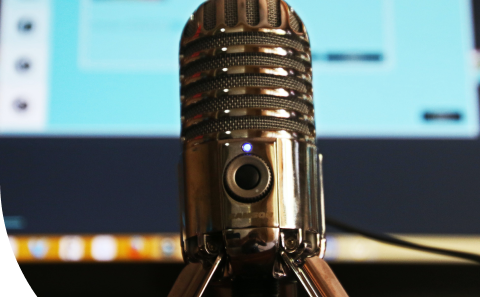
Are you a global marketing professional with stories to share?
Popular Posts
Popular industry news, interviews, technologies, and resources.
